高等岩石力学课程报告英文读书报告
- 格式:docx
- 大小:98.64 KB
- 文档页数:3
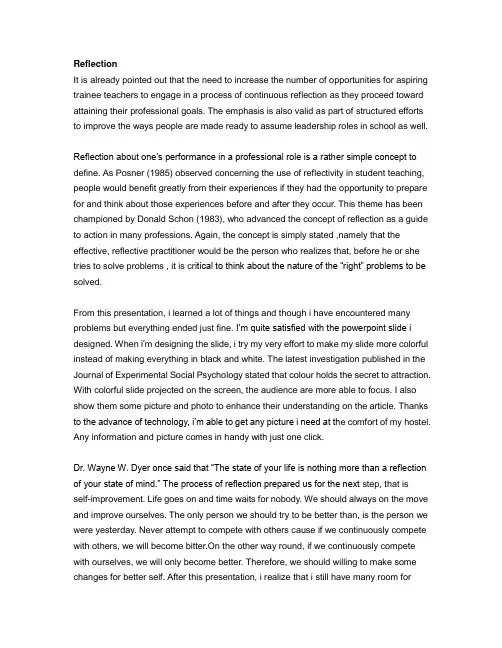
ReflectionIt is already pointed out that the need to increase the number of opportunities for aspiring trainee teachers to engage in a process of continuous reflection as they proceed toward attaining their professional goals. The emphasis is also valid as part of structured efforts to improve the ways people are made ready to assume leadership roles in school as well.Reflection about one’s performance in a professional role is a rather simple concept to define. As Posner (1985) observed concerning the use of reflectivity in student teaching, people would benefit greatly from their experiences if they had the opportunity to prepare for and think about those experiences before and after they occur. This theme has been championed by Donald Schon (1983), who advanced the concept of reflection as a guide to action in many professions. Again, the concept is simply stated ,namely that the effective, reflective practitioner would be the person who realizes that, before he or she tries to solve problems , it is cr itical to think about the nature of the “right” problems to be solved.From this presentation, i learned a lot of things and though i have encountered many problems but everything ended just fine. I’m quite satisfied with the powerpoint slide i designed. When i’m designing the slide, i try my very effort to make my slide more colorful instead of making everything in black and white. The latest investigation published in the Journal of Experimental Social Psychology stated that colour holds the secret to attraction. With colorful slide projected on the screen, the audience are more able to focus. I also show them some picture and photo to enhance their understanding on the article. Thanks to the advance of technology, i’m able to get any picture i need at th e comfort of my hostel. Any information and picture comes in handy with just one click.Dr. Wayne W. Dyer once said that “The state of your life is nothing more than a reflection of your state of mind.” The process of reflection prepared us for the next step, that isself-improvement. Life goes on and time waits for nobody. We should always on the move and improve ourselves. The only person we should try to be better than, is the person we were yesterday. Never attempt to compete with others cause if we continuously compete with others, we will become bitter.On the other way round, if we continuously compete with ourselves, we will only become better. Therefore, we should willing to make some changes for better self. After this presentation, i realize that i still have many room forimprovement. One thing i would change about my presentation this time is on the information provided. I will find more extra information and wide-range data for my presentation next time. I will arm myself to the teeth because the audience may throw any question any time. So i have to be ever-ready with the adequate information to fulfill the curiosity of the audience. Besides, i will do more reading in order to sharpen my mind.As Toni Morrison says in The Dancing Mind , "reading is to experience one's own mind dancing with another's."I think the content of my presentation is contented and knowledgeable. The title of my first article is 5 threats to California from climate change. I chose this article purposely so that the au dience is exposed to what’s happening around the globe instead of just around of us. Besides, i choose the latest news happened in California so that the audience can catch up with the up-to-date information. I would like to led my audience to look outside the box so that they can be more alert to problem facing by our mother nature. My second article is Playing God with the climate. It is an article about crazy ideas suggested by scientists in order to save our Earth. There are many unbelievable ideas suggested by geo-engineerers and the audience may encounter some difficulty in order to accept the ideas. Anyway, i’m glad that the audience show interest for my second article . They even ask me for further information after i’m done with my presentation.Th e old saying that “eyes are a reflection of your inner self” holds true in most cases. There are a lot of meanings to eye contact and it is considered as a basic component of social interaction in some cultures. Some people struggle to make eye contact with others. Failing to make eye contact suggests to some that you're shy to others, it indicates that you are not confident enough and sometimes can also be taken as a disrespect. Julia Minson, a psychologist and assistant professor at Harvard’s Kennedy Sch ool of Government and her collaborator, Frances Chen realized that staring at someone will make the person more likely to see your point. After this presentation, I think that i did not make sufficient eye contact. I was too awkward and nervous that time. I did attempt to make some eye contact, but any efforts i made was proven in vain. Sufficient eyes contact is very important so that the listener can get our sincerity and hence, more willing to accept our ideas. I should improve my eye contact for the presentations to come. Maybe next time i can try to look for some friendly face among the audience first and look them in their eyes so that i can be more relax and easy to make such attempt.The influential German scholar Wilhelm Wundt, who in 1900 published the first volume of his Völkerpsychologie, which contains an extensive discussion of gesture, claimed that primordial speech was a kind of gesticulation that "mirrored the soul." From this, we can know the importance of effective gestures and movement. I think that i did not make many effective movement and gestures on the stage. Well, at least i should be more at ease and not that tensed up.This will enable the audience to be more relax and get rid of the awkward situation. Besides, the audience will focus more on the message i delivered if i attempt to make some effective gestures to lure their attention.Repetition is the mother of learning , the father of action , which makes it the architect of accomplishment. (Zig Ziglar). This quote show us how im portant practice is. “Practise makes perfect”, that’s how a saying goes. I did not practise much for this time presentation. I just go through my script on that very day and do it on the spot. I think i should practise more so that i can find out my mistakes earlier and able to make some changes before it is too late. Next time, maybe i can try standing in front of a mirror for practising so that i can catch my expression while i’m talking. Besides, i will try to record down my voice and listen to it. By using this method, i can improve on my pronunciation. I can also improve on the tone of my voice so that they’re not flat and monotonous. I will try to make some “ups and downs” in my tone to lure the audience’s attraction. I will practise in front of my friends and family too in order to build up my confident and make me more prepared to such environment.I’m very glad to have this chance of speaking in front of others. There are a couple of things that I do feel I lack the confidence and skill to perform. In my future, I hope to carry all of the skills I wish to acquire. I feel that I am much better now, in talking in front of others. The responsibility I have gained during this experience is incredible and has taught me to be a much more organized person. I found that all of these responsibilities have made me realize that I could definitely take the next step forward in my academic career. Each new experience I involve myself in has made me continue to grow and constantly learn something new.(1385 words)。
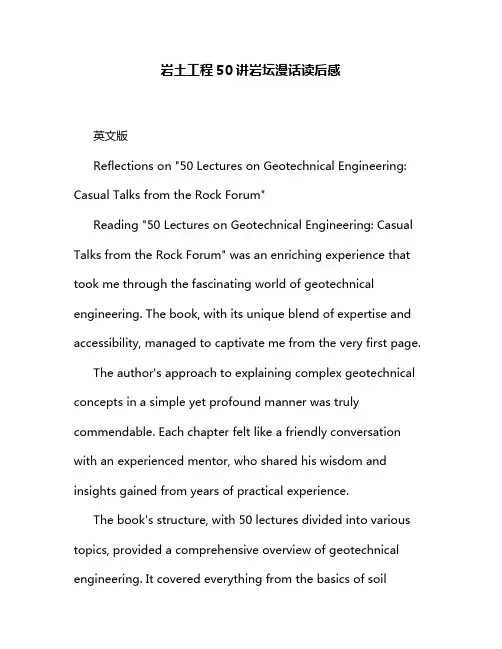
岩土工程50讲岩坛漫话读后感英文版Reflections on "50 Lectures on Geotechnical Engineering: Casual Talks from the Rock Forum"Reading "50 Lectures on Geotechnical Engineering: Casual Talks from the Rock Forum" was an enriching experience that took me through the fascinating world of geotechnical engineering. The book, with its unique blend of expertise and accessibility, managed to captivate me from the very first page.The author's approach to explaining complex geotechnical concepts in a simple yet profound manner was truly commendable. Each chapter felt like a friendly conversation with an experienced mentor, who shared his wisdom and insights gained from years of practical experience.The book's structure, with 50 lectures divided into various topics, provided a comprehensive overview of geotechnical engineering. It covered everything from the basics of soilmechanics and rock mechanics to advanced topics like slope stability, foundation design, and geotechnical testing methods.What stood out for me was the author's emphasis on practical applications and real-world case studies. These examples not only helped me understand the theoretical concepts better but also gave me a glimpse into the challenges and solutions encountered in real-life geotechnical projects.The book also highlighted the importance of continuous learning and adaptation in the field of geotechnical engineering. With technology and research constantly evolving, it's crucialfor professionals to stay updated and informed.In conclusion, "50 Lectures on Geotechnical Engineering: Casual Talks from the Rock Forum" is a must-read for anyone interested in geotechnical engineering. It's a book that not only educates but also inspires, making it a valuable addition to any professional's library.中文版《岩土工程50讲岩坛漫话》读后感阅读《岩土工程50讲岩坛漫话》是一次充实的经历,它带领我深入到了岩土工程这一迷人领域。
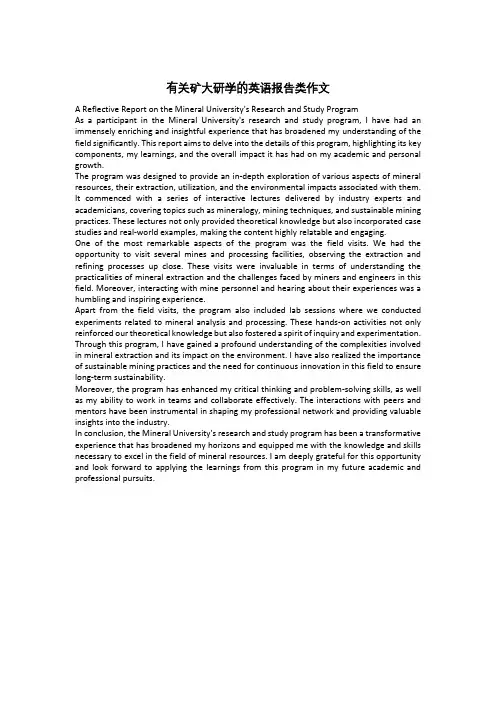
有关矿大研学的英语报告类作文A Reflective Report on the Mineral University's Research and Study ProgramAs a participant in the Mineral University's research and study program, I have had an immensely enriching and insightful experience that has broadened my understanding of the field significantly. This report aims to delve into the details of this program, highlighting its key components, my learnings, and the overall impact it has had on my academic and personal growth.The program was designed to provide an in-depth exploration of various aspects of mineral resources, their extraction, utilization, and the environmental impacts associated with them. It commenced with a series of interactive lectures delivered by industry experts and academicians, covering topics such as mineralogy, mining techniques, and sustainable mining practices. These lectures not only provided theoretical knowledge but also incorporated case studies and real-world examples, making the content highly relatable and engaging.One of the most remarkable aspects of the program was the field visits. We had the opportunity to visit several mines and processing facilities, observing the extraction and refining processes up close. These visits were invaluable in terms of understanding the practicalities of mineral extraction and the challenges faced by miners and engineers in this field. Moreover, interacting with mine personnel and hearing about their experiences was a humbling and inspiring experience.Apart from the field visits, the program also included lab sessions where we conducted experiments related to mineral analysis and processing. These hands-on activities not only reinforced our theoretical knowledge but also fostered a spirit of inquiry and experimentation. Through this program, I have gained a profound understanding of the complexities involved in mineral extraction and its impact on the environment. I have also realized the importance of sustainable mining practices and the need for continuous innovation in this field to ensure long-term sustainability.Moreover, the program has enhanced my critical thinking and problem-solving skills, as well as my ability to work in teams and collaborate effectively. The interactions with peers and mentors have been instrumental in shaping my professional network and providing valuable insights into the industry.In conclusion, the Mineral University's research and study program has been a transformative experience that has broadened my horizons and equipped me with the knowledge and skills necessary to excel in the field of mineral resources. I am deeply grateful for this opportunity and look forward to applying the learnings from this program in my future academic and professional pursuits.。
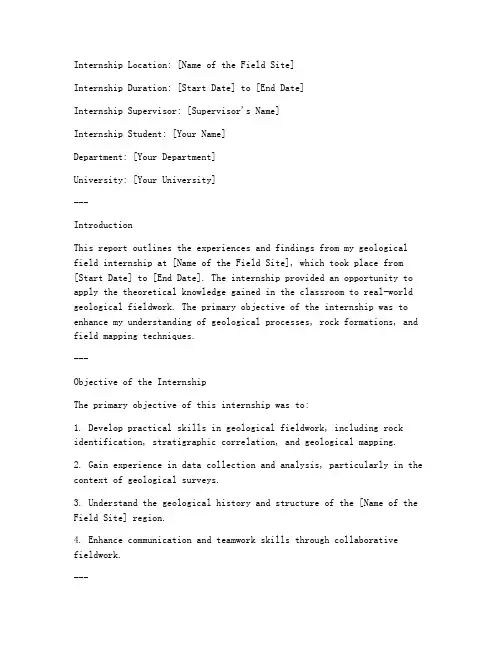
Internship Location: [Name of the Field Site]Internship Duration: [Start Date] to [End Date]Internship Supervisor: [Supervisor's Name]Internship Student: [Your Name]Department: [Your Department]University: [Your University]---IntroductionThis report outlines the experiences and findings from my geological field internship at [Name of the Field Site], which took place from [Start Date] to [End Date]. The internship provided an opportunity to apply the theoretical knowledge gained in the classroom to real-world geological fieldwork. The primary objective of the internship was to enhance my understanding of geological processes, rock formations, and field mapping techniques.---Objective of the InternshipThe primary objective of this internship was to:1. Develop practical skills in geological fieldwork, including rock identification, stratigraphic correlation, and geological mapping.2. Gain experience in data collection and analysis, particularly in the context of geological surveys.3. Understand the geological history and structure of the [Name of the Field Site] region.4. Enhance communication and teamwork skills through collaborative fieldwork.---MethodologyThe internship was conducted in several phases:1. Pre-Fieldwork Preparation: Prior to the fieldwork, I reviewed relevant literature and geological maps of the [Name of the Field Site] region to familiarize myself with the geological setting.2. Fieldwork Activities: During the fieldwork phase, I participated in the following activities:- Rock Identification: I collected and identified various rock types and minerals, recording their characteristics and descriptions.- Stratigraphic Correlation: I observed and documented the stratigraphic succession of rock units, noting any unconformities or structural features.- Geological Mapping: I used a compass and topographic maps to create detailed geological maps of the study area.- Data Collection: I collected geological data, including elevation, strike, dip, and rock type, using appropriate tools and techniques.3. Data Analysis: After the fieldwork, I compiled and analyzed the collected data, using geological software to create cross-sections and isopach maps.---ResultsThe following are the key findings from the internship:1. Rock Types: The [Name of the Field Site] region is characterized by a variety of rock types, including sedimentary, igneous, and metamorphic rocks.2. Stratigraphic Succession: The stratigraphic succession shows a clear progression from older to younger units, with several unconformities indicating periods of erosion and non-deposition.3. Structural Features: The study area exhibits a complex geological structure, including folds, faults, and joints, which have influenced the distribution of rock units.4. Geological Map: The geological map of the study area illustrates the distribution of rock types, stratigraphic units, and structural features.---DiscussionThe geological fieldwork at [Name of the Field Site] provided valuable insights into the geological processes that have shaped the region. The identification of rock types and stratigraphic correlation helped in understanding the geological history of the area. The mapping exercises enhanced my skills in geological surveying and interpretation.The complex geological structure observed during the internship suggests that the [Name of the Field Site] region has undergone significant geological events, such as tectonic activity and erosion. The findings from this internship can be used to further investigate the geological potential of the region for various applications, such as mineral exploration and land-use planning.---ConclusionThe geological field internship at [Name of the Field Site] was a valuable learning experience that allowed me to apply my geological knowledge in a real-world setting. The practical skills acquired during the internship, such as rock identification, stratigraphic correlation, and geological mapping, will be beneficial in my future studies and career. I am grateful to [Supervisor's Name] for guiding me through the internship and providing opportunities for growth and development.---References[Include any relevant references used during the internship, such as geological maps, literature, or software manuals.]---Appendices[Include any additional material, such as geological maps, photographs, or data tables, that support the findings of the internship.]。
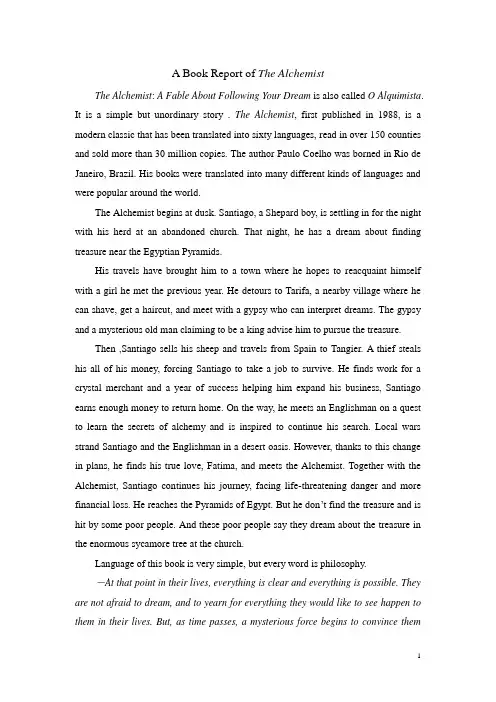
A Book Report of The AlchemistThe Alchemist: A Fable About Following Your Dream is also called O Alquimista. It is a simple but unordinary story . The Alchemist, first published in 1988, is a modern classic that has been translated into sixty languages, read in over 150 counties and sold more than 30 million copies. The author Paulo Coelho was borned in Rio de Janeiro, Brazil. His books were translated into many different kinds of languages and were popular around the world.The Alchemist begins at dusk. Santiago, a Shepard boy, is settling in for the night with his herd at an abandoned church. That night, he has a dream about finding treasure near the Egyptian Pyramids.His travels have brought him to a town where he hopes to reacquaint himself with a girl he met the previous year. He detours to Tarifa, a nearby village where he can shave, get a haircut, and meet with a gypsy who can interpret dreams. The gypsy and a mysterious old man claiming to be a king advise him to pursue the treasure.Then ,Santiago sells his sheep and travels from Spain to Tangier. A thief steals his all of his money, forcing Santiago to take a job to survive. He finds work for a crystal merchant and a year of success helping him expand his business, Santiago earns enough money to return home. On the way, he meets an Englishman on a quest to learn the secrets of alchemy and is inspired to continue his search. Local wars strand Santiago and the Englishman in a desert oasis. However, thanks to this change in plans, he finds his true love, Fatima, and meets the Alchemist. Together with the Alchemist, Santiago continues his journey, facing life-threatening danger and more financial loss. He reaches the Pyramids of Egypt. But he don’t find the treasure and is hit by some poor people. And these poor people say they dream about the treasure in the enormous sycamore tree at the church.Language of this book is very simple, but every word is philosophy.―At that point in their lives, everything is clear and everything is possible. They are not afraid to dream, and to yearn for everything they would like to see happen to them in their lives. But, as time passes, a mysterious force begins to convince themthat it will be impossible for them to realize their destiny.―When you want something, all the universe conspires in helping you to achieve it.They were said by the king of Salem. The two sentences were the most impressive sentences to me. I got the central theme of the book——pursuing dream. We should believe our dreams, if we have the strong desire to achieve it , it will be real. When I first read this sentence, I felt a bit ridiculous. It seems like a slogan. However, just like the book told us, When the huge wealth is right in front of us, but we never notice. That is because people don't believe the treasure is there. We often reject it but never try, and it may be a big psychological obstacle for us to follow our dreams. In my opinion, maybe we should believe what the book told us——when you want something, all the universe conspires in helping you to achieve it. Different people have different feelings about the book. As for me, the most impression I got was the description of dream. Actually, everyone can got his own philosophy. I believe that when I want something, all the universe conspires in helping me to achieve it. So there is no need to be afraid of those obstacles in our life. We should smile to pursuit our dreams. Only in this way can we look forward to a youth without regrets.。

哈利波特魔法石英语读书报告《Harry Potter and the Philosopher's Stone》is a masterpiece of British author J.K. Rowling. It is a landmark work in the Harry Potter series, which tells the story of a teenager named Harry Potter, who is a orphan, but possesses extraordinary magic skills.The story takes place in a parallel world, where magic exists and is commonly used. At the age of 11, Harry Potter receives a letter from Hogwarts School of Witchcraft and Wizardry, where he starts his magical education. At Hogwarts, he meets his two best friends, Ron Weasley and Hermione Granger, and together they explore the school and embark on an adventure to protect the Philosopher's Stone, which is said to have the power to immortality.The book is written in simple English, which is easy to understand for most readers. The language is lively and vivid, painting a rich picture of the magical world in the minds of readers. The characters are well-developed, with each possessing unique personality traits that make them easy to identify with. The plot is full of suspense and surprises, keeping readers on the edge of their seats.One of the most prominent themes in the book isfriendship. Harry, Ron, and Hermione's unbreakable friendship and their willingness to face any danger to protect each other is a testament to the power of friendship. Another important theme is courage. Harry displays great courage throughout the story, facing challenges that would make most adults tremble.The book has been adapted into a movie franchise by Warner Bros., which has received critical acclaim for its visual effects and adaptations of the source material. The franchise has also earned billions of dollars at the box office, making it one of the most successful movie franchises in history.In conclusion, "Harry Potter and the Philosopher's Stone" is a must-read for any fan of the genre. It is a masterpiece that explores themes of friendship, courage, and the power of love, while providing an immersive magical world that will leave readers spellbound.。
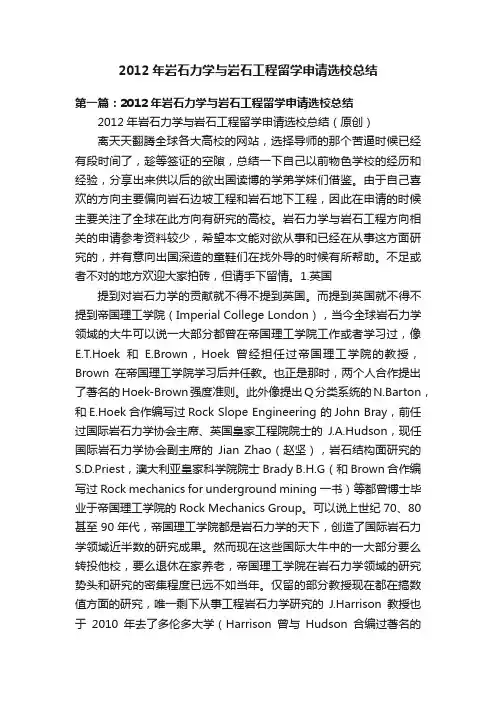
2012年岩石力学与岩石工程留学申请选校总结第一篇:2012年岩石力学与岩石工程留学申请选校总结2012年岩石力学与岩石工程留学申请选校总结(原创)离天天翻腾全球各大高校的网站,选择导师的那个苦逼时候已经有段时间了,趁等签证的空隙,总结一下自己以前物色学校的经历和经验,分享出来供以后的欲出国读博的学弟学妹们借鉴。
由于自己喜欢的方向主要偏向岩石边坡工程和岩石地下工程,因此在申请的时候主要关注了全球在此方向有研究的高校。
岩石力学与岩石工程方向相关的申请参考资料较少,希望本文能对欲从事和已经在从事这方面研究的,并有意向出国深造的童鞋们在找外导的时候有所帮助。
不足或者不对的地方欢迎大家拍砖,但请手下留情。
1.英国提到对岩石力学的贡献就不得不提到英国。
而提到英国就不得不提到帝国理工学院(Imperial College London),当今全球岩石力学领域的大牛可以说一大部分都曾在帝国理工学院工作或者学习过,像E.T.Hoek和E.Brown,Hoek曾经担任过帝国理工学院的教授,Brown在帝国理工学院学习后并任教。
也正是那时,两个人合作提出了著名的Hoek-Brown强度准则。
此外像提出Q分类系统的N.Barton,和E.Hoek合作编写过Rock Slope Engineering 的John Bray,前任过国际岩石力学协会主席、英国皇家工程院院士的J.A.Hudson,现任国际岩石力学协会副主席的Jian Zhao(赵坚),岩石结构面研究的S.D.Priest,澳大利亚皇家科学院院士Brady B.H.G(和Brown合作编写过Rock mechanics for underground mining一书)等都曾博士毕业于帝国理工学院的Rock Mechanics Group。
可以说上世纪70、80甚至90年代,帝国理工学院都是岩石力学的天下,创造了国际岩石力学领域近半数的研究成果。
然而现在这些国际大牛中的一大部分要么转投他校,要么退休在家养老,帝国理工学院在岩石力学领域的研究势头和研究的密集程度已远不如当年。
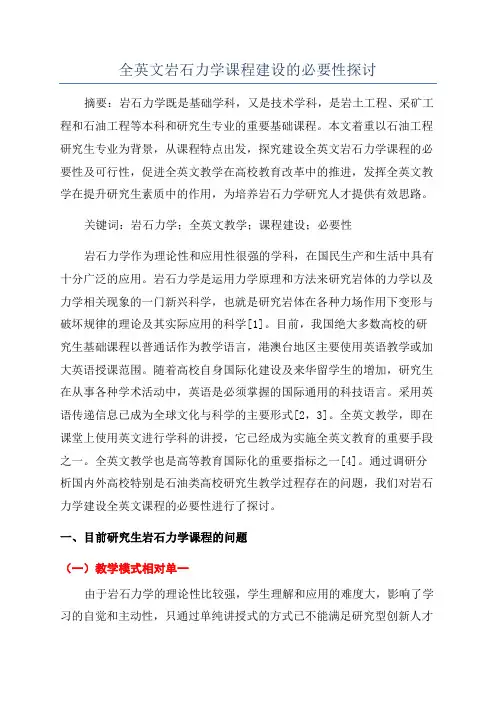
全英文岩石力学课程建设的必要性探讨摘要:岩石力学既是基础学科,又是技术学科,是岩土工程、采矿工程和石油工程等本科和研究生专业的重要基础课程。
本文着重以石油工程研究生专业为背景,从课程特点出发,探究建设全英文岩石力学课程的必要性及可行性,促进全英文教学在高校教育改革中的推进,发挥全英文教学在提升研究生素质中的作用,为培养岩石力学研究人才提供有效思路。
关键词:岩石力学;全英文教学;课程建设;必要性岩石力学作为理论性和应用性很强的学科,在国民生产和生活中具有十分广泛的应用。
岩石力学是运用力学原理和方法来研究岩体的力学以及力学相关现象的一门新兴科学,也就是研究岩体在各种力场作用下变形与破坏规律的理论及其实际应用的科学[1]。
目前,我国绝大多数高校的研究生基础课程以普通话作为教学语言,港澳台地区主要使用英语教学或加大英语授课范围。
随着高校自身国际化建设及来华留学生的增加,研究生在从事各种学术活动中,英语是必须掌握的国际通用的科技语言。
采用英语传递信息已成为全球文化与科学的主要形式[2,3]。
全英文教学,即在课堂上使用英文进行学科的讲授,它已经成为实施全英文教育的重要手段之一。
全英文教学也是高等教育国际化的重要指标之一[4]。
通过调研分析国内外高校特别是石油类高校研究生教学过程存在的问题,我们对岩石力学建设全英文课程的必要性进行了探讨。
一、目前研究生岩石力学课程的问题(一)教学模式相对单一由于岩石力学的理论性比较强,学生理解和应用的难度大,影响了学习的自觉和主动性,只通过单纯讲授式的方式已不能满足研究型创新人才培养的需求[5-8]。
同时岩石力学的理论推导的要求比较高,并和实际工程结合比较紧密,因此仅靠传统的教学讲授方式,不能提高研究生独立自主学习的能力。
传统的教学模式过于强调书本,不能很好地进行理论与实践相结合,学生的实际运用能力相对较差,学习的兴趣和积极性不高,对教师教授的知识不敢表达自己的看法和意见,批判性能力不高。
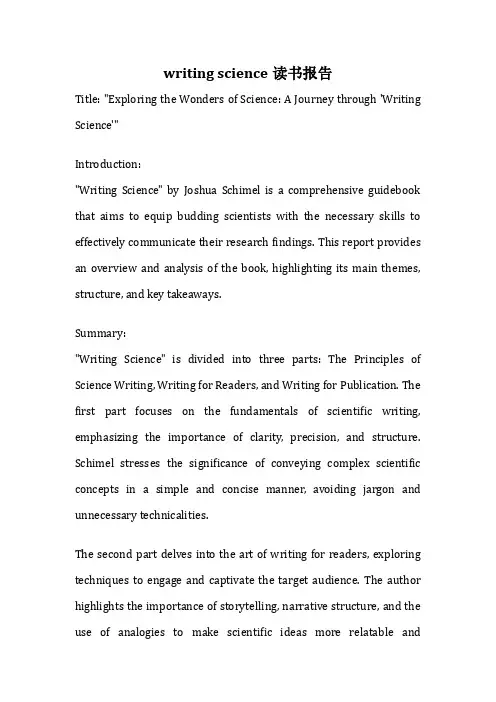
writing science读书报告Title: "Exploring the Wonders of Science: A Journey through 'Writing Science'"Introduction:"Writing Science" by Joshua Schimel is a comprehensive guidebook that aims to equip budding scientists with the necessary skills to effectively communicate their research findings. This report provides an overview and analysis of the book, highlighting its main themes, structure, and key takeaways.Summary:"Writing Science" is divided into three parts: The Principles of Science Writing, Writing for Readers, and Writing for Publication. The first part focuses on the fundamentals of scientific writing, emphasizing the importance of clarity, precision, and structure. Schimel stresses the significance of conveying complex scientific concepts in a simple and concise manner, avoiding jargon and unnecessary technicalities.The second part delves into the art of writing for readers, exploring techniques to engage and captivate the target audience. The author highlights the importance of storytelling, narrative structure, and the use of analogies to make scientific ideas more relatable andaccessible. Schimel also emphasizes the need to consider the reader's background knowledge and level of expertise when crafting scientific narratives.The final part of the book delves into the nuances of writing for publication. Schimel provides valuable insights on how to structure and format scientific papers, effectively present data, and craft compelling abstracts and introductions. The author also addresses the challenges of peer review and offers tips to navigate this crucial stage of the publication process.Analysis:"Writing Science" offers a practical and accessible approach to scientific writing. Schimel's emphasis on clarity and simplicity aligns with the growing demand for science communication that can be understood by a broader audience. The book's structure, with its clear division into three parts, allows readers to easily navigate and reference specific sections as needed.One of the book's strengths lies in its focus on the reader. Schimel emphasizes the importance of understanding the target audience and tailoring the writing style to their needs. By incorporating storytelling and analogies, scientists can bridge the gap between their research and the general public, fostering a greater appreciation andunderstanding of scientific discoveries.Additionally, "Writing Science" provides valuable guidance on the publication process, which can often be daunting for early-career scientists. The author provides practical advice on structuring papers, addressing reviewers' comments, and maximizing the impact of research through effective writing.Conclusion:"Writing Science" is a valuable resource for scientists at all stages of their careers. By emphasizing clarity, simplicity, and effective storytelling, Joshua Schimel equips researchers with the tools to communicate their findings to a broader audience. This book serves as a guide to scientific writing, helping scientists navigate the challenges of sharing their research with the world.。
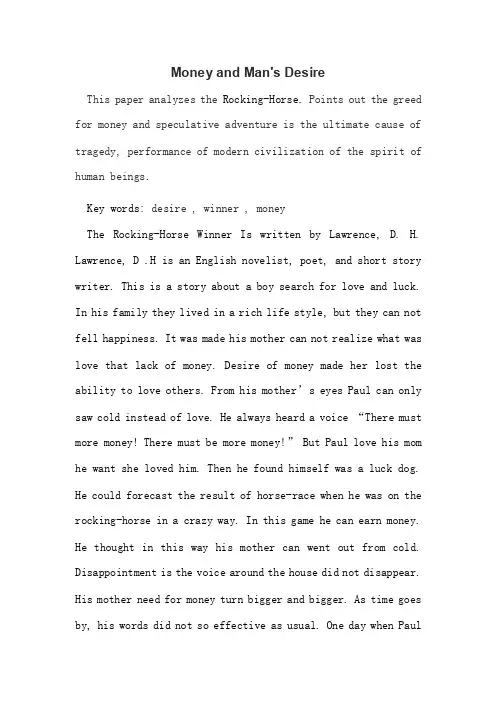
Money and Man's DesireThis paper analyzes the Rocking-Horse. Points out the greed for money and speculative adventure is the ultimate cause of tragedy, performance of modern civilization of the spirit of human beings.Key words: desire , winner , moneyThe Rocking-Horse Winner Is written by Lawrence, D. H. Lawrence, D .H is an English novelist, poet, and short story writer. This is a story about a boy search for love and luck. In his family they lived in a rich life style, but they can not fell happiness. It was made his mother can not realize what was love that lack of money. Desire of money made her lost the ability to love others. From his mother’s eyes Paul can only saw cold instead of love. He always heard a voice “There must more money! There must be more money!” But Paul love his mom he want she loved him. Then he found himself was a luck dog. He could forecast the result of horse-race when he was on the rocking-horse in a crazy way. In this game he can earn money. He thought in this way his mother can went out from cold. Disappointment is the voice around the house did not disappear. His mother need for money turn bigger and bigger. As time goes by, his words did not so effective as usual. One day when Paulwas predicing the result of next horse-race his mother came in his house and he felt out off the rocking-horse and lost his young life.In depicting a prosperous household that still hungers for money, "The Rocking-Horse Winner" resembles many of Lawrence's other fictional critiques of materialism and modern society. Paul's mother desires wealth and material possessions to the exclusion of more valuable items such as love and self-knowledge. Her desires are never satisfied, however, and they result in disastrous consequences when love and money are confused. A sexual subtext—another element found in many of Lawrence's works—also seems to be present in the story. Scholars have noted that the descriptions of Paul riding his rocking-horse have an erotic quality, and these scenes have been interpreted as representations of sex and masturbation. Since these quasi-sexual actions are focused on pleasing Paul's mother, and since Paul's father has proven incapable of satisfying his wife, many critics believe that the story draws on the concepts of psychologist Sigmund Freud. Freud maintained that young boys are sexually attracted to their mothers and fantasize about replacing their fathers—a condition he termed the Oedipus complex. Other analysts have placed less emphasison the sexual aspects of the story and instead view Paul's actions as a tragic attempt to win parental love from his hard-hearted mother."The Rocking-Horse Winner" is hailed by some critics as a technically perfect short story. Frequently anthologized and exhaustively analyzed, "The Rocking-Horse Winner" has scholars divided over interpretations—whether it is a social commentary on money and relationships in a capitalist society, a psychoanalytic exploration of sexuality and the Oedipus complex, or a simple fable of a boy searching for identity and love. The society is lopsided.The boy Paul through the betting money, the boy's mother, uncle and other for money is crazy to win money in gambling, the value of the people died. In the Trojan winner ", the pursuit of money distorted the greatest affection, the mother precious mother can't love son and son for love, but can use the money to buy. Mother love is not so, and became the source of the root cause son tragedy. From this point of view, this story also reflects the son of negative influence mothers.Story discusses Lawrence concerns relationships between people, from a reflection of the western industrial society to health money harmonious interpersonal relationships.At the beginning of the story D. H. Lawrence said “There was a woman who was beautiful, who start with all the advantages, yet she had no luck. She married for love, and the love turned to dust ” These beautiful wards for a kind mother is normal, and the story looked like a fairy tale. The Mother was born in a wealthy family, originally is one understands love and love the beautiful woman. She married for love "unluck" husband. But love is not brought her hopes of a happy life. She began to pursuit of material life. Although they are living in the beautiful house and garden, also have a baby-sitter, please. But as a pursuit of material in the era of couples, they do not earn enough to pay for the pursuit and the society as the lavish mode of living. However, they often worry for money. On the contrary, the hard, not apathy her gentleness docile. Children love to have lost the ability. Lost love, numbness, a stone cold mother image is produced by the industrial revolution of the human mind, money consciousness of humanity and alienation. People in increasing physical life, inevitably become slaves to money and material. When more than one value of wealth, people will go to their tails and change as material.D. H. Lawrence according to this story The Rocking-Horse.In the modern society again exposed human weaknesses, affectionand the spirit of the alienation.This story is written at the end of 19th century, at that time Capitalist industrial development and industrialization. In material life level at the same time, the person's mental state changes. The pursuit of material life leads to excessive loss of human nature, shallow. In this story the mother is a representative. She cared about nothing but money, when her son was going to die she was just cold and stay by herself without anything to do. She turn to be a stone.The analysis of Paul. First, psychological - the infinite greed for money, young Paul for money and don't have much too keen on mother's infection, but understand family status. Began to pursue money on. Then tragedy happened. Second, Action acquired by speculative adventure -- for Paul speaking, only money in order to meet the needs of the mother. And Paul completely is also a gambler's image of money very greed, although he is passive.Third, End - die for money in capitalist society, hesitate speculative adventure, hesitate the greed for money. Suffice it to say that money SINS. I n this novel through character of alienation, Lawrence revealed the dark side of modern civilization, money dominate everything. Even theprecious family also received physical erosion, modern has fallen, irrational state.References:《劳伦斯评论集》上海文艺出版社《英国文学选读》。
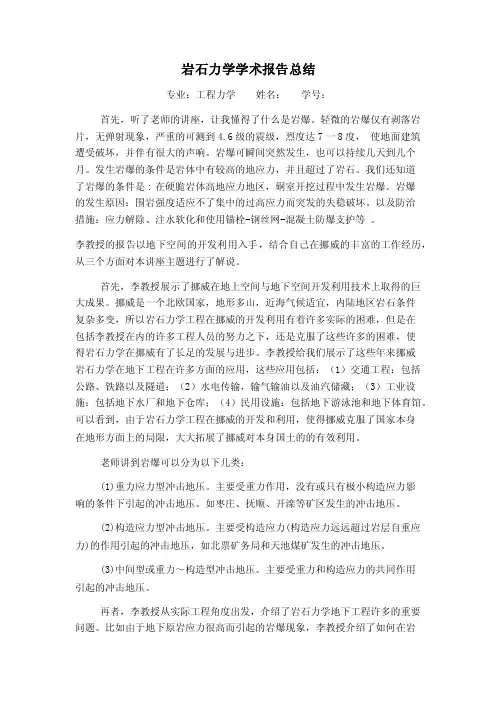
岩石力学学术报告总结专业:工程力学姓名:学号:首先,听了老师的讲座,让我懂得了什么是岩爆。
轻微的岩爆仅有剥落岩片,无弹射现象,严重的可测到4.6级的震级,烈度达7一8度,使地面建筑遭受破坏,并伴有很大的声响。
岩爆可瞬间突然发生,也可以持续几天到几个月。
发生岩爆的条件是岩体中有较高的地应力,并且超过了岩石。
我们还知道了岩爆的条件是:在硬脆岩体高地应力地区,硐室开挖过程中发生岩爆。
岩爆的发生原因:围岩强度适应不了集中的过高应力而突发的失稳破坏。
以及防治措施:应力解除、注水软化和使用锚栓-钢丝网-混凝土防爆支护等。
李教授的报告以地下空间的开发利用入手,结合自己在挪威的丰富的工作经历,从三个方面对本讲座主题进行了解说。
首先,李教授展示了挪威在地上空间与地下空间开发利用技术上取得的巨大成果。
挪威是一个北欧国家,地形多山,近海气候适宜,内陆地区岩石条件复杂多变,所以岩石力学工程在挪威的开发利用有着许多实际的困难,但是在包括李教授在内的许多工程人员的努力之下,还是克服了这些许多的困难,使得岩石力学在挪威有了长足的发展与进步。
李教授给我们展示了这些年来挪威岩石力学在地下工程在许多方面的应用,这些应用包括:(1)交通工程:包括公路、铁路以及隧道;(2)水电传输,输气输油以及油汽储藏;(3)工业设施:包括地下水厂和地下仓库;(4)民用设施:包括地下游泳池和地下体育馆。
可以看到,由于岩石力学工程在挪威的开发和利用,使得挪威克服了国家本身在地形方面上的局限,大大拓展了挪威对本身国土的的有效利用。
老师讲到岩爆可以分为以下几类:(1)重力应力型冲击地压。
主要受重力作用,没有或只有极小构造应力影响的条件下引起的冲击地压。
如枣庄、抚顺、开滦等矿区发生的冲击地压。
(2)构造应力型冲击地压。
主要受构造应力(构造应力远远超过岩层自重应力)的作用引起的冲击地压,如北票矿务局和天池煤矿发生的冲击地压。
(3)中间型或重力~构造型冲击地压。
《岩石力学与工程学报》中、英文版提升质量的实践
佘诗刚;吕红
【期刊名称】《评价与管理》
【年(卷),期】2013(011)002
【摘要】2013年4月27日下午,中科院《岩石力学与工程学报》常务副主编余诗刚编审作了题为“《岩石力学与工程学报》中、英文版提升质量的实践”的大会报告,报告由武汉大学中国科学评价研究中心副主任、博士生导师赵蓉英教授主持。
首先简要介绍了《岩石力学与工程学报》(以下简称《学报》)的发展现状,发展潜力,接着分析了影响科技期刊质量的要素,总结出影响潜在作者投稿的主要因素为品牌、同行评议、编辑策略等。
其次,从充分依靠学会、编委会和承办单位的作用,采取措施全面提高稿件质量,编辑人才的培养与激励,稿件的合理分流等方面详细阐述了如何确保期刊质量。
最后,总结了期刊发展中存在的不足及面临的挑战和机遇,提出了积极筹建《学报》理事会,继续狠抓《学报》学术质量和编辑质量,控制论文发表周期等几点展望。
【总页数】1页(P16)
【作者】佘诗刚;吕红
【作者单位】中科院《岩石力学与工程学报》编辑部
【正文语种】中文
【相关文献】
1.《岩石力学与岩土工程学报》英文版第一届编委会会议纪要 [J],
2.《岩石力学与工程学报》中、英文版2011年度工作总结和2012年工作计划[J],
3.《岩石力学与工程学报》创刊30周年暨英文版启动5周年庆典活动安排 [J],
4.《岩石力学与工程学报》创刊30周年暨英文版启动5周年庆典活动安排 [J],
5.《岩石力学与岩土工程学报》英文版第一届编委会第二次扩大会议会议纪要 [J],因版权原因,仅展示原文概要,查看原文内容请购买。
<专业英语>读书报告PART 1 English-Chinese TranslationLesson 20:Engineering Problem-Solving MethodologyPART 2Technical WritingMODERN MACHINE DESIGN TECHNOLOGIES姓名:胡建专业:械设计制造及其自动化班级:08625学号:20083013901192011.12.07PART 1 English-Chinese TranslationLesson 20:Engineering Problem-Solving Methodology第二十课:工程师解决问题的方法论(1-6段)许多年来,在很多工业和科技领域,工程师们已经赢得了作为注重细节,善于寻出正确答案的的思维清晰的思考者应得的声望。
他们不仅获得了尊重,并且大众对他们设计并制造的产品也给与了足够的信任与信心。
工程师们希望彼此之间提出的计算结果,测试结果,技术工作能够清楚简洁,令人信服,有凭有据。
机械工程中每个数量都由两部分组成:数值和单位,失去其中一个那么另一个也将变得毫无意义。
并且在职工程师在密切注意数字的同时也同样密切注意单位是否正确。
除了单位的问题,工程师们还必须获得问题的数据结果,如材料的强度是多少?质量是多少?在什么温度?等等。
他们通常面对着一些不确定和未完善的一些信息。
在一项设计的开始阶段,例如,最终产品的形状和尺寸并不确定,如果是这样的话,就没有必要在第一步去设计它们,仅仅粗略的估计一下就可以了。
然而,工程师仍然有工作要做,并且这些形状与尺寸必须从某处开始设计。
因此,工程师们用近似法给那些仍然不知道的数值赋值,虽然那些近似法并不完美,但是肯定比随意猜测和什么都不做要好。
机械工程师们用他们的常识、经验、直觉、判断力、和物理定律通过一种叫数量级近似法的方法去寻找答案,而且机械工程师很乐意做出合理的近似。
地质资源与地质工程(代码0818)攻读硕士学位研究生培养方案一.学科专业简介地质资源与地质工程是东华理工大学的特色与优势学科,是江西省“十二五”高水平学科。
该学科主要有以下4个研究方向:(1)矿产勘查与评价:主要研究矿产形成的地质背景、成矿条件,研究矿床地质特征、成矿作用机制,探索矿产的空间分布规律和时间演化规律,建立成矿模式;研究科学有效的矿产预测、勘查和评价的理论与技术方法。
(2)地球探测与信息技术:利用专门的仪器接收来自地下各种物理信息,应用数学物理方法提取或分离有用信息,结合地质条件对有用信息进行解释,推断探测对象在地下赋存的位置、范围和产状。
它是地质矿产勘查和地质基础研究不可或缺的重要手段。
(3)地质工程:主要研究水文地质与工程地质等领域的地质工程问题。
(4)核废物地质处置:主要针对高放废物的地质处置库选址、核素的迁移规律等方面开展研究。
二.研究方向1.矿产普查与勘探2.地球探测与信息技术3.地质工程4.核废物地质处置三.培养目标1.认真掌握马克思主义基本理论,树立爱国主义思想,培养团队意识,具有很强的事业心和责任感,遵纪守法,具有良好的道德品质和学术修养,身心健康。
2.具有严谨的治学态度、优良的科学作风和学术道德;具有本学科领域较扎实的基础理论和较深入系统的专门知识;具有学术创新能力、开拓精神和独立从事地质资源与地质工程学科领域科学研究工作的能力;在科学或工程技术研究领域取得明显成绩;具有良好的文化素养和综合素质。
3.掌握一门外语,能熟练阅读专业外文资料,并具有较好的科技写作能力。
四.课程设置注:①非学位课程的公共选修课中,素质教育课程有:体育(篮球、排球、足球、网球、羽毛球、乒乓球、健美操、太极拳等内容)、第二外国语、科学研究技能(论文写作方法、文献检索等内容)、形势政策解读与就业指导、创造学与创造性思维;②跨学科选修课程由各学院推荐一门课。
要求具有公共性、普及性(如马克思主义学院推荐的公共选修课程为《自然辨证法概论》),不能推荐专业性太强的课程。
Reading reportPaper title: A new hard rock TBM performance prediction model for project planningMajor: 隧道与地下工程Name: 叶宇航Number: 1530767Several models have been introduced over the years for prediction of hard rock TBM performance.The TBM performance prediction models are mostly based on an empirical or a semi-theoretical approach. Although they have advantages and area of applications, they also have disadvantages, such as CSM model don’t consider the main influencing parameter, NTNU model require special experiments originated from the drilling, QTBM are too complicated. The authors hope to better understand machine-rock interaction and to develop a more accurate model for performance estimate of hard rock TBMs. In order to achieve it, the authors investigate the field data of three main tunneling projects in Iran and Manapouri tunnel project in New Zealand. The data obtained from the projects as before mention including geological and performance parameters, have wide ranges of variations. But these wide ranges of geological and performance parameters helped in developing a more comprehensive TBM performance prediction model which has covered different geological conditions.In general, to justify the use of TBM in any project and for planning purposes, a reasonably accurate estimation of rate of penetration (ROP), daily rate of advance (AR), and cutter cost/life estimate is necessary. But the authors chosen Field Penetration Index (FPI) which is a composite parameter as the machine parameter. In the text, both single and multi-variable regression analyzes were used to investigate relationship between engineering rock properties and TBM performance parameters and finally to develop empirical equation. The analysis of the data obtained from the projects proved that FPI is a suitable machine performance parameter for developing empirical relationships with geological parameters. And multi-variable regression analysis show good correlation between ln (FPI) as response parameter and UCS and RQD as predictors. In conclusion FPI is a good parameter for the evaluation of hard rock TBM performance. Therefore, the authors developed a chart of FPI prediction. This chart can be used for quick estimation of range of values for FPI in grounds with different rock strength and rock quality.Excepts the FPI, the authors also concerned the boreability. Boreability is the term commonly used to express the ease or difficulty of rockmass excavation by a tunnel boring machine. Rock mass boreability depends on a number of influencing parameters including intact rock/rock mass properties, machine specifications and operational parameters. In tunneling projects, ground characteristics or boreability of the rockmass is an important parameter for selecting machine type and specifications. It is clear that proper evaluation of rock mass boreability can also play a major role in machine operation to achieve the best performance. FPI can be selected as an index for categorizing rock mass boreability. Based on the analysis of give projects, the authors defined six rock mass boreability classes, from most difficult for boring or B-0 class(Tough) to easiest for boring or B-V class (Excellent). Considered the relationship between FPI and boreability, the authors give a table of TBM performance estimation in rock masses with different boreability classes.All in all, the paper proposed a simple model to evaluate rock mass boreability and TBM performance range. This model demonstrates that machine performance has been related to two main rock properties (UCS and RQD) and two operational parameters (average cutter head thrustand RPM).These Input parameters of the model are available in the preliminary stages of the tunnel design and planning. From this paper, I have a much better understanding of the estimation of TBM performance and the impact factors of FPI and boreability. And I think the model proposed in this paper can be applied as a useful tool for quick estimation of TBM performance in projects with different geological conditions and machine diameters. And this model is worth using widely.The new boreability classification which based on rock masses characteristics to allow for prediction of FPI values also worth learning. The authors adopt both single and multi-variable regression to analyze the relationship between engineering rock properties and TBM performance parameters. As a result, it obtains a good result. So, I think when we investigate a problem which influenced by various parameters, we can consider not just single parameter but multi-variable regression. In the process of developed model, varieties of charts which demonstrate the relationship between different parameter play an important role. Thus, chart is an important tool for research. In engineering project, theoretical model should be easy to use so that it can play an important role in project planning. So, I think the classes of rock mass boreability defined in the paper is useful to engineering field.。
Abstract:This report details the experimental procedure and findings of the "Stone Gate of Destiny" project, an innovative scientific endeavor aimed at exploring the potential of time manipulation and quantum entanglement. The experiment, conducted over a period of six months, involved the construction of a sophisticated machine capable of manipulating thefabric of time and space. The report discusses the theoretical framework, experimental setup, results, and implications of the experiment.1. IntroductionThe concept of the Stone Gate of Destiny has long intrigued scientists and philosophers alike. The idea that time is a river that can be manipulated and altered has fascinated humanity for centuries. In recent years, advancements in quantum physics have provided new insights into the nature of time and space, suggesting that manipulation of these fundamental aspects of reality might be possible. The Stone Gate of Destiny project was initiated to test the feasibility of such manipulation and to explore its potential applications.2. Theoretical FrameworkThe theoretical foundation of the Stone Gate of Destiny project isrooted in the principles of quantum mechanics and general relativity. Quantum mechanics, with its probabilistic nature and phenomena like entanglement and superposition, challenges our classical understandingof reality. General relativity, on the other hand, describes gravity as the curvature of spacetime. By combining these theories, we can begin to envision a framework for manipulating time and space.3. Experimental SetupThe experimental setup for the Stone Gate of Destiny project involvedthe construction of a complex machine, known as the Quantum Entanglement Manipulator (QEM). The QEM was designed to create and maintain entangled particles, which could then be manipulated to alter the flow of time. The machine consisted of the following components:- Quantum Entanglement Generator (QEG): This component was responsible for creating entangled particles using a laser and a crystal.- Entanglement Amplifier (EA): The EA was used to amplify the entanglement between the particles, making them more susceptible to manipulation.- Time Manipulation Unit (TMU): The TMU was the core of the QEM, capable of manipulating the spacetime fabric to alter the flow of time.- Control Interface (CI): The CI allowed operators to input commands and monitor the progress of the experiment.4. Experimental ProcedureThe experiment was conducted in three phases:Phase 1: Calibration and TestingIn this phase, the QEM was calibrated and tested to ensure its functionality. The QEG was used to create entangled particles, which were then amplified by the EA. The TMU was activated to manipulate the particles, and the CI was used to monitor the changes in their state.Phase 2: Time ManipulationIn this phase, the QEM was used to manipulate the flow of time. The experimenters set specific targets for time manipulation, such as delaying or advancing the passage of time by a certain duration. The CI was used to input these commands, and the TMU executed the manipulation.Phase 3: Data Analysis and VerificationIn this final phase, the experimenters analyzed the data collected during the time manipulation phase. They compared the results to the expected outcomes and verified the accuracy of the QEM.5. ResultsThe results of the Stone Gate of Destiny project were both surprising and promising. The QEM was successfully used to manipulate the flow of time, with varying degrees of success. In some cases, the experimenterswere able to delay or advance the passage of time by several minutes. However, the process was not without its challenges. The QEM required precise control and was susceptible to external interference, which often led to unpredictable outcomes.6. ImplicationsThe successful manipulation of time has profound implications for science and society. It could potentially revolutionize fields such as medicine, telecommunications, and transportation. The ability to control time could also have ethical and moral implications, raising questions about the nature of free will and the potential for misuse of the technology.7. ConclusionThe Stone Gate of Destiny project has demonstrated the potential of manipulating time and space using quantum entanglement. While the experiment is still in its early stages, the results are promising and suggest that further exploration in this field could lead to groundbreaking advancements. The future of time manipulation is bright, and the possibilities are endless.8. AcknowledgmentsThe authors would like to thank the following individuals and organizations for their support and assistance in the Stone Gate of Destiny project:- The Quantum Physics Department at [University Name]- The National Science Foundation- The Institute for Advanced Study9. References- Einstein, A., & Podolsky, B. (1935). Can Quantum-Mechanical Description of Physical Reality Be Considered Complete? Physical Review, 47(10), 777-780.- Hawking, S. (1988). A Brief History of Time: From the Big Bang to Black Holes. Bantam Books.- Penrose, R. (2004). The Road to Reality: A Complete Guide to the Laws of the Universe. Vintage Books.。
Reading report of the book A journey to the center of the earth------By FloraA Journey to the Center of the Earth is a classic science fiction by Jules Verne that remains as wonderfully popular and attractive today as when it was first published more than 120 years ago. Recognized as one of Jules Verne's finest novel, it contains that unique combination of believable science and wonderment that made Jules Verne the father of modern science fiction. From a scientific point of view, this story has not aged quite as well as other Verne stories, since most of his ideas about what the interior of the Earth contains have since been proven wrong. However, a redeeming point to the story is Verne's own belief, told within the novel from the viewpoint of a character, that the inside of the Earth does indeed differ from that which the characters encounter. Compared to his previous works, Verne takes a radically different way to tell the story by creating a 19-year-old boy who relates the events as his own adventures.In the book, a strange German professor Otto Liedenbrock, discovered a paper from an ancient Icelandic book, which was left by a great sixteen century scientist and great traveler, Aren Saknussemm, and attempted to learn the meaning of the mysterious writings. He worked for a long time, but still couldn’t understand the real meaning. the professor locked everyone in the house and forced himself and the others to go without food until he cracked the code. His nephew, Axel, finally discovered the secret of the old Icelandic parchment, which tells of a hidden underground pathway leading to the center of the Earth. Although Axel had many doubts about the journey, his uncle, professor Liedenbrock persuaded him to join him on the trip, travelling to the Iceland, the deep into the Earth, where they discovered a new world of ancient animals, plants and an underground sea. In three months’ journey, they met many difficulties and frustrations, and finally they came back to the surface of the Earth. They started their journey from Germany to a volcano, Sneffels, in Iceland. In Iceland, professor Liedenbrock and his nephew met a Icelandic scientist. The scientist introduced them a tour guide, Hans, who gave the professor and his nephew great help in their long tough journey. The three men began their journey in July, from the entrance of the volcano, Sneffels. This was a very dangerous journey. They suffered from many obstacles and frustrations and had almost lost their lives. Under the help of Hans, they used the stings they took to the end of the volcano’s entrance. At there, they found two ways.The professor chose one of them without any consideration. After several days’ trek, under the ground, it was even more disappointing, although they had accorded to Aren Saknussemm’s direction. So they had to return to the original cross. When they finally went back to the branch road, Axel was too tired and desperate to go on their journey, and said that they should come back to the surface of the Earth or they would die of extreme exhaustion and lack of water and food. Although the professor felt a bit worried, he still suggested continuing their journey for one more day.Thanks to Hans’ diligence and cleverness , they found a underground river and solved this problem, so they were saved and decided to go on. Several days later, they found a way which leaded to the underground. They followed this way. Axel was walking in front of the three persons, and soon he found that he was separated with his companions and got lost in the dark. He was in despair and tried to go back. After four days’ efforts and suffering, he was luckily found by his uncle and Hans with his head deeply hurt by the falling stones. After a fewdays’ recovery, Axel heard the voice of waves and thought he saw the light. Actually, they arrived at a piece of underground sea. From this term on, there were many scientific miracles appeared. When they explored in the seaside district, they found a thick forest made of mushrooms. These mushrooms were thirty or forty feet tall. The professor explained to the surprised Axel about the possibility that plants could alive underground. They continued, and found some bones of huge animals and evidences that other animals and plants could still be alive in the mysterious forest. The professor decided to pass through the underground sea to go on their journey to the center of the Earth. When they were passing through the sea, they met strong storms in and almost were eaten by some ancient animals which they hadn’t seen on the surface of the Earth, and almost lost their lives.At the other side of the underground sea, there was another forest, which was made by ferns and pine. Even more surprising was that they saw some huge animals and a man nearly twelve feet high. This let them doubted about the origin of human. They then found a rusty knife. The professor thought this knife was made in sixteen century. It must be took there by people. That was to say, someone had come here before. Later, they saw two words “A” and “S” on a stone, at an entrance of a path. These two letters must be left by Aren Saknussemm. So, this path must be the right way. But unfortunately, the path was blocked by stone. Then they decided to use gunpowder to make the path could be go through. They fired the fuse and back to the raft they made. After opened the path, the seawater flowed in, their raft was rushed into the hole and was fall fast. Their food and other things were lost. They were hungry, but the bigger problem was that the temperature was rising quickly. The water beneath their raft was boiling. Professor said that there would be a volcano explosion. They were just above the lava and would be threw out of the volcano explosion and got the chance of getting back to the surface of the Earth. When Axel opened his eyes, he found they were lying on the side of a mountain. The best thing was that they were OK. They went down the mountain and knew they were in Stromboli in Italy from a young boy. Their journey finished. Having gone through one volcano in Iceland, but they have come out through another one in Italy, more than three thousand miles away from Iceland. The professor and his nephew came back to Germany, and their guider Hans, who gave them great help along the journey, went back to Iceland. Then their journey was over. The professor was awarded the honor of the great. And his nephew Axel, became hero, too. Besides, he got his beloved girl Grauben’s adoration. After reading this book, what impressed me most are professor Liedenbrock’s enthusiasm about pursuing science and his spirit of adventure. Professor Liedenbrock was a careful and adventurous German scientist. He was never afraid of difficulties and hardship in terms of his research and he was acknowledged as the scientific authority. He was an energetic and quick-tempered person. Based on his rich knowledge, he insisted on his desire to start a fantastic but full of difficulties journey to the center of the earth regardless of his nephew’s prevention and without any hesitation. When the long journey began, challenges and obstacles had never gave up to weight their burdens. But the professor faced all of them bravely and never thought of surrendering. But he did have attic faith and strong will with his funny stubborn. So I know that we must have the spirit of adventure and unremitting spirit when we do everything. on the other hand, Liedenbrock , this kind of person can make a serious scientific imaging theme become more relaxing, active, interesting, and vivid. This is why Jules took advantage of this man’s personalities, scientific aptitude and status tocomplete the boring prolixity of natural scientific principles.There is a special person named Hans who had played an important role in the tough journey, a guide from Iceland, is totally different from Professor Liedenbrock in disposition. He is calm and peaceable and pays no attention to anything except his salary. Even his words are so succinct. But he is confident, fervent and helpful .The motivation of his joining this exploration had no common with his companions .He is just for a living. Because of this reason, even though they were trapped in a very dangerous situation, Hans would stick to asking for his 3 dollars weekly salary. Yet, thanks to Han’ appearance, Jules could easily solve all the problems during the journey. As far as I am concerned, I prefer this simple and direct kind of person to people like the professor for they are so nice, plain and warm-hearted and they don’t care about reputation and success do they don’t have to bear risks. Therefore, they live a peaceful life with their families. This is the kind of life which I want to possess. As for another main character in the fiction, “I”in this book is the professor’s nephew Axel ,he is smart, caring and quick-witted. When he ran across difficulties, he could faced them bravely. Although at the beginning, he refused to go with his uncle because of fear and also because he couldn’t leave hi girl-his uncle’s daughter Grauben. But, it can’t be denied that he was just a 19-year-old boy with no decision .But under the pressure from his uncle, he had to leave his warm home in Hamburg and started his adventurous journey into the centre of the Earth. What he thought all day was nothing in addition to eating and sleeping,of course, and looking forward to return home. He was even not able to control his destiny. After a lot of tests including hunger ,thirsty, darkness, labyrinths ,heat, and so on, he gradually began to enjoy the adventure and grew up. When he returned home in the end, he got admiration of Grauben, too. Although the 3 heroes finally didn’t arrive in the centre of the Earth ,Jules has already attained his point: the whole procedure of adventuring the centre of the Earth was the procedure of becoming a real man for Axel after experiencing hardship and obtaining a new life.And another character I’d like to talk about is the professor’s daughter, also Axel’s sweetheart, Grauben. When his father decided to be involved in an adventurous and dangerous journey with Axel, the pretty young lady showed full support rather than worry or anxiety. Meanwhile, when Axel showed fear and unwillingness, she gave him enough encouragement, too.In addition, there was another person in the story even though he had never appeared formally .He was the first person who had got to the centre of the Earth and succeeded in returning to the surface of the Earth---Arne Saknussemm, not only an Icelandic name, but of a learned professor of the sixteenth century, a celebrated alchemist. The description of this man was indirect and not long, but it was this person that always played an important role of guiding our heroes’ adventure, pushing the key plot and grapping the rhythm of the novel. Overall, I think the book is not only easily understandable but also of vital importance to stimulate readers to pursue their .By finish reading this book, I knew much knowledge about strata structure and archaeology. But in my opinion, there is no another world in the center of the Earth, because it is quite hot in it, and the temperature must be pretty high so that animals plants and human beings can’t live there. it is said at the last chapter that they were threw out of the Earth by a volcano explosion, but I don’t this matter will happen in our real life. even though, I still love this novel which is full of imagination and scientific knowledge. Allin all, Journey to the Center of the Earth written by Jules Verne is really worth reading. We can not only learn lots of professional knowledge, but also enlarge our vocabulary. After reading this book, I thought a lot about life. In our real lives , maybe many people want to live a warm ,comfortable and safe life without danger and hardship during. If we live like a snail and always hide in our houses when we meet dangers, how can we experience the beauty and the meaning of life? A person’s lifetime should be wonderful and meaningful, we should persist on exploring our life and trying our best to fight for our life goals so that we can cultivate ourselves and bravely accept life challenges and finally obtain success. In a word, I strongly recommend this fiction.。
Reading reportPaper title: A new hard rock TBM performance prediction model for project planningMajor: 隧道与地下工程Name: 叶宇航Number: 1530767Several models have been introduced over the years for prediction of hard rockTBM performance.The TBM performanceprediction models are mostly based on an empirical or a semi-theoretical approach. Although they have advantages and area of applications, they also have disadvantages, such as CSM model don’t consider the main influencing parameter, NTNU model require special experiments originated from the drilling, QTBM are too complicated. The authors hope to better understand machine-rock interaction and to develop a more accurate model for performance estimate of hard rock TBMs.In order to achieve it, the authors investigate the field data of three main tunneling projects in Iran and Manapouri tunnel project in New Zealand.The data obtained from the projects as before mention includinggeological and performance parameters,have wide ranges of variations.Butthese wide ranges of geological and performance parameters helped in developing a more comprehensive TBM performance prediction model which has covered different geological conditions.In general, to justify the use of TBM in any project and for planning purposes, a reasonably accurate estimation of rate of penetration (ROP), daily rate of advance (AR), and cutter cost/life estimate is necessary. But the authors chosen Field Penetration Index(FPI) which is a composite parameter as the machine parameter. In the text, both single and multi-variable regression analyzes were used to investigate relationship between engineering rock properties and TBM performance parameters and finally to develop empirical equation. The analysis of the data obtained from the projects proved that FPI is a suitable machine performance parameter for developing empirical relationships with geological parameters.And multi-variable regression analysis show good correlation between ln (FPI) as response parameter and UCSand RQD as predictors. In conclusionFPI is a good parameter for the evaluation ofhard rockTBM performance. Therefore, the authors developed a chart of FPI prediction.This chart can be used for quick estimationof range of values for FPI in grounds with different rockstrength and rock quality.Excepts the FPI, the authors also concerned the boreability. Boreability is the term commonly used to express the ease or difficulty of rockmass excavation by a tunnel boring machine. Rock mass boreability depends on a number of influencing parameters including intact rock/rock mass properties, machine specifications and operational parameters. In tunneling projects, ground characteristics or boreability of the rockmass is an important parameter for selecting machine type and specifications. It is clear that proper evaluation of rock mass boreability can also play a major role in machine operation to achieve the best performance. FPI can be selected as an index for categorizing rock mass boreability. Based on the analysis of give projects, the authors defined six rock massboreability classes, from most difficult for boring or B-0 class(Tough) to easiest for boring or B-V class (Excellent). Considered the relationship between FPI and boreability, the authors give a table of TBM performance estimation in rock masses with different boreability classes.All in all, the paper proposeda simplemodel to evaluate rock mass boreability and TBM performancerange. This model demonstrates that machine performance hasbeen related to two main rock properties (UCS and RQD) and twooperational parameters (average cutter head thrust andRPM).These Input parameters of the model are available in the preliminary stages of the tunnel designand planning.From this paper, I have a much better understanding of the estimation ofTBM performance and the impact factors of FPI and boreability. And I think the model proposed in this paper can be applied as a usefultool for quick estimation of TBM performance in projects with differentgeological conditions and machine diameters. And this model is worth using widely.The new boreability classification which based on rock masses characteristics to allow for prediction of FPI values also worth learning. The authors adopt both single and multi-variable regression to analyzethe relationship between engineering rock properties and TBM performance parameters. As a result, it obtains a good result. So, I think when we investigate a problem which influenced by various parameters, we can consider not just single parameter butmulti-variable regression. In the process of developed model, varieties of charts which demonstrate the relationship between different parameter play an important role. Thus, chart is an important tool for research.In engineering project, theoretical model should be easy to use so that it can play an important role in project planning. So, I think the classes of rock massboreabilitydefined in the paper is useful to engineering field.。